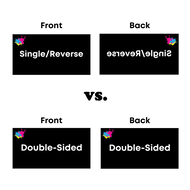Single Reverse vs. Double-Sided Flags: What’s the Difference?
Posted by Alex on Oct 15, 2025

If you've ever shopped for a flag, you probably've heard the words double-sided and single reverse. They sound confusing on the surface—but understanding the difference is important if you don't want your flag flying wrong. If it's the American flag, a POW/MIA flag, or a custom logo flag, it will assist you in making the right decision if you understand how each one is put together and how they fly.
What is a Single Reverse Flag?
A single reverse flag is the most common type you’ll see. It’s made by printing or sewing the design on one side of the fabric. The ink or stitching then bleeds through to the back side, creating a mirror image.
Front side: Reads correctly (left to right).
Back side: Reads backward (a reversed image).
Purpose: Designed for flying freely in the wind on a flagpole.
Because most flags in the U.S.—including the American flag—are flown single reverse, double-sided is standard. It's lightweight, gusts well in the wind, and usually less costly than double-sided flags.
What is a Double-Sided Flag?
A double-sided flag is made differently. Instead of being printed on one side, it's really two flags glued together with a liner in the middle to prevent see-through. That means the writing reads correctly on both sides.
Front side: Reads correctly.
Back side: Reads correctly too (not reversed).
Use: Great for flags where writing or design must be readable from both sides.
Since it's essentially two flags combined in one, a double-sided flag is heavier and more durable, but might not fly quite as freely in light winds. They're also more expensive because of the additional material and work.
Key Differences at a Glance
| Feature | Single Reverse | Double-Sided |
|---|---|---|
| Appearance | Correct on front, reversed on back | Correct on both sides |
| Weight | Lightweight | Heavier (two layers + liner) |
| Movement in Wind | Flies easily, even in light winds | Flies less freely, needs stronger winds |
| Cost | More affordable | Higher cost |
| Best Use | General display, patriotic flags | Advertising, custom flags with text/logos |
Use Single Reverse if:
You want a traditional flag (like the U.S. flag or state flag).
You want an easy-flying, light-weight choice.
You're on a tight budget.
Use Double-Sided if:
Your flag has important text (like business names or event signage).
You want clear readability of the design from either approach.
Durability and projection are more valuable than price.
Final Thoughts
Single reverse vs. double-sided flags: neither is "better" necessarily—it just depends on how you're going to be using your flag. If you want one that catches the breeze and is a great-looking pole sittter, single reverse is the way to go. But if your flag has some text or branding that must always be legible, double-sided is the way to go.
Whichever one you choose, a well-designed flag is more than fabric—it's a statement of pride, remembrance, or identity.
Order the Right Flag for You
Ready to order the right flag for your house, office, or event? Do you require single reverse flags or double-sided flags? Don't worry, we've got you covered with high-quality products that will last.
Frequently Asked Questions (FAQ)
- Are double-sided flags longer-lasting than single reverse flags?
Not really. Both will last a good while if made with good materials. Double-sided flags are heavier and may take wind differently, but as they are two flags sewn together, they may also wear a bit along the seaming.
2. Why are single reverse flags more common?
Single reverse flags are lighter, wind-beneficial, and less costly. That is why all U.S. and state flags you've ever noticed are single reverse.
3. Are you able to read text on a single reverse flag?
Yes—on the front. On the back, the letters will be reversed. If your flag has important wording (like a company name), a double-sided flag is the better choice.
4. Which is best used outdoors?
Both are fine to use outdoors. Single reverse flags are appropriate for general show and routine flying, and double-sided flags are ideal when visibility of text or logos is paramount from every direction.
